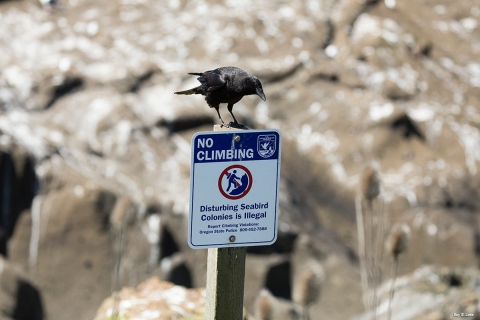Facility Rules and Policies
Much of Oregon Islands NWR is designated as National Wilderness and is closed to public use. All coastal rocks and islands are off-limits and closed to the public. All watercraft should remain at least 500 feet away to avoid disturbance of wildlife.
There is no public access to the rocks, reefs and islands of this refuge at any time. Fishing is permitted from surrounding waters. Oregon Islands National Wildlife Refuge can be experienced from locations all along the coastline. See a list of some of the best areas here.
Coquille Point in Bandon, OR, is the only portion of Oregon Islands NWR which is open to the public. See here for Rules and Policies associated with this location.
All 1,854 rocks, reefs and islands of Oregon Islands National Wildlife Refuge and nine rocks and islands of Three Arch Rocks National Wildlife Refuge are closed to the public at all times. These National Wildlife Refuges are maintained for the protection of wildlife. People are not permitted to climb, scramble, or access rocks, sea stacks or islands. Doing so may disturb wildlife and harm habitat.
In addition to being sanctuary for wildlife, these lands are designated National Wilderness Areas: “where the earth and its community of life are untrammeled by man, where man himself is a visitor who does not remain.” These areas enjoy the most stringent restrictions of all federal lands in the U.S., managed to preserve Wilderness characteristics. Learn more about National Wilderness Areas.
It is illegal to operate unmanned aircraft from Refuge lands this includes launching and landing from them. Special Use Permits may be issued when drone use is deemed appropriate. National Wildlife Refuge System lands are often home to threatened and endangered species—these wildlife can be disproportionately affected by drone flights. Disturbing wildlife is illegal. Fines can be levied if a drone is observed disturbing wildlife, e.g. flushing nesting birds from an offshore island or causing resting seals or sea lions to flee for the water, regardless of where the operator is standing. For more information on drone use over refuges, consult the Service's UAS Resource Guide. Check out a detailed guide to responsible drone use and download our quick guide for pilots.
Keep your distance from wildlife resting on rocks and beaches. All migratory birds are protected under the Migratory Bird Treaty Act, which applies to all seabirds, and all Marine Mammals are protected under the Marine Mammal Protection Act (MMPA). These Acts forbid the harassment of these animals, which includes disturbance of any kind. The MMPA advises beachgoers to stay at least 50 yards away from marine mammals. A good rule of thumb is: if the animal reacts to your presence or activities, you are too close! For a surefire way to observe wildlife without undue disturbance, bring binoculars, a spotting scope, or camera.
The unauthorized operation of aircraft or aerial devices, including sail planes, kites, hang gliders, or other activities at altitudes resulting in harassment of wildlife, or the unauthorized take-off or landing on a National Wildlife Refuge, except in an emergency, is prohibited. National Wildlife Refuge boundaries are designated on up-to-date FAA aeronautical charts. Seabirds and Marine Mammals are protected under multiple federal acts and disturbing them is illegal. A good rule of thumb is: if the animal reacts to your activities, you are too close! Download the guide for pilots for more information!
Please stay away from the refuge islands to avoid disturbance to nesting seabirds and marine mammals. See this boating poster for more information.


